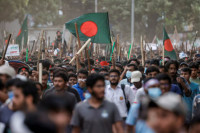Opinion
The Singapore model
Foreign and Nepali politicians often refer to Singapore as one of the model nations when it comes to planning for a ‘new Nepal’, even though our own country is almost five times older than Singapore.
Jaya Jung Mahat & Prem Prasad Upadhayaya
Foreign and Nepali politicians often refer to Singapore as one of the model nations when it comes to planning for a ‘new Nepal’, even though our own country is almost five times older than Singapore. But Singapore has come a long way since its independence in 1965. Pragmatic policies, commitment, accountability and tireless efforts by Lee Kuan Yew, the founding father of Singapore, have contributed to this development miracle. There are key strategies that helped Singapore remain strong on the world map and lessons that Nepal could learn from.
A top performer
An island with an area of 720square kilometres, Singapore is home to about 5.5 million residents. Roughly 74 percent of the population is Chinese, 13 percent Malays, 9 percent Indians, and 3 percent are of other origins. It has a GDP per capita of 69,283 Singapore Dollars ($55,182)—almost 70 times higher than Nepal’s, and it maintains top positions in other international rankings.
Singapore has been thriving in an unprecedented way through locally contextualised politics. It has no natural resources, but Lee Kuan Yew understood that ‘people are everything’. He invested in them and believed in meritocracy to deliver development.
The dominance of Chinese Singaporeans is often considered one of the major factors that led to the separation of Singapore from Malaysia. Thus, in the post-independence era, the country adopted inclusive social policies that would help harmonise relations between citizens from different ethnicities. Hard work and self-reliance were extremely valued. Lee believed that all are born equal. He made huge investments in, and ensured equal opportunities to, all citizens in education, healthcare, employment, and social unity. Through a ‘many helping hands’ approach and ‘self-help’ community initiatives, the country could ensure participation of each individual, and meritocracy has remained the leading principle of every sector in the country.
Becoming a major player
Singapore started to move away from import-substitution by attracting multinationals during the mid-1960s, when only a few other countries had practised such strategies. Also, substantial investments for developing competent human capital, creation of industrial clusters and reforms of labour laws and fiscal and monetary policies helped Singapore achieve a competitive advantage. During this period, the country managed to maintain a 10 percent annual growth rate on average. Later Singapore revised its economic policies and liberalised key service sectors like finance, business and telecommunications to remain competitive. Such a ‘learning by doing’ reform approach helped Singapore graduate from the third world to the first world in a single generation.
Singapore has also proven that small states can be major players in world politics. Trade networks, inter-regional groups and engagement are some of the diplomatic tools Singapore has been pursuing to boost its global standing. It has broken out of the ‘small-state mentality’ to think beyond borders. With limited land space at home, it believes in building industrial parks abroad. Its diplomatic dealings are fair, neutral, and mutually beneficial to all involved. It is the domestic strength and international trust that Singapore earned since its independence.
Both Singapore and Nepal are multi-racial, multi-cultural, and multi-lingual countries. Singapore has been practicing a dynamic social policy to strengthen national identity by protecting interests of all groups, and developing a common space to enjoy social life. Everyone is treated fairly without any discrimination. The minor-
ity’s representation in the political process is ensured through Group Representation Constituencies (GRCs). Every public housing estate has an equal share of different ethnic groups to foster harmonious relations. These insights will be instrumental for Nepal to realise federalism.
Breaking the inferiority complex
Like Singapore, Nepal too is surrounded by giant economies. If we could develop suitable and balanced economic policies and strategies, our industries could have direct access to the Indo-Chinese market of over 2.5 billion people. To achieve this, we need to focus on a high-end-value and export-oriented economic model rather than on an import-substitution one.
Breaking an ‘inferiority complex mentality’ in pursuing foreign policy goals must be at the forefront of Nepal’s external dealings. Singapore succeeded in positioning itself as a crucial player in the world economy. Nepal must also participate in trade networks and inter-regional groups, and engage actively in geopolitics in order to boost its standing with other economies.
Singapore has proven that the size and the population of a nation do not necessarily determine a country’s prosperity; its social, economic, and foreign policies and strategies do. There are two things that Nepal must learn from the Singapore model. First, we must gain internal strength through economic prosperity and social harmony. Second, external dealings must focus on national interests rather than on partisan interests. Despite being a landlocked country, these two nation-building principles could help Nepal survive and escape the vicious cycle of underdevelopment.
Mahat, an alumnus of Lee Kuan Yew School of Public Policy, National University of Singapore, is a Kathmandu-based public policy researcher; Upadhayaya works at the Office of the Prime Minister and Council of Ministers, Government of Nepal




 13°C Kathmandu
13°C Kathmandu












